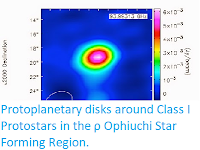The Ophiuchus Molecular Cloud is a dense molecular cloud roughly 125 parsecs (408 light years) from Earth in the constellation of Ophiuchus, that forms one of the closest areas of star-formation to the Earth. This region contains over 200 known T Tauri stars (very young stars which have not yet begun to generate heat by hydrogen
fusion, but which produce considerable energy through gravitational
heating) and at least 16 protostars (stars which are still gaining mass by accretion from a
surrounding disk, the accretion disk, and are emitting ionised
material in jets from their poles). Elias 2-24 is a T Tauri star within the Ophiuchus Molecular Cloud with an estimated age of 400 000 years and mass roughly equal to that of the Sun. This star is surrounded by a protoplanetary disk (a dense structure from which planets are thought to form) from which matter is still actively accreting onto the star, and which is roughly edge on when seen from Earth, making it a good candidate for observation by astronomers trying to understand these structures.
In a paper published on the arXiv database at Cornell University Library on 18 November 2017, and accepted for publication in the Astrophysical Journal Letters, a team of scientists led by Lucas Cieza of the Facultad de Ingenier a y Ciencias, N ucleo de Astronom a at the Universidad Diego Portales, and the Millennium Nucleus Center of Protoplanetary Disks in ALMA Early Science, describe the results of a study of the Elias 2-24 Protoplanetary Disk made with the Atacama Large Millimeter/Submillimeter Array (ALMA) on 13 and 14 July 2017.
Cieza et al. immaged the Elias 2-24 Protoplanetary Disk at a range of wavelengths, intended to detect the densities of different molecules. Molecules will absorb light as energy across a broad part of the
spectrum, but can only absorb a finite amount of light before being forced to
re-emit some of this energy. However this energy is not released in random
bursts, but radiated at specific frequencies determined by the atoms present in
the molecule, which atoms are bound to which other atoms, and even which isotopes
of each element are present. This gives each molecule its own unique
spectrographic signature, which can be used by astronomers to detect different
molecules in distant objects such as protoplanetary disks.
Using this method Cieza et al. were able to detect three distinct gaps in the protoplanetary disk around Elias 2-24, at distances of 20, 52, and 87 AU from the star (i.e. 20, 52 and 87 times as far from the star as Earth is from the Sun), and have widths of 6, 28 and 11 AU, respectively. Such gaps in protoplanetaty disks are thought to be caused by the formation of planets, as matter from the disk accretes onto the forming protoplanetary body. Calculating the amount of matter that would be missing from the disks in this gap, Cieza et al. suggest that enough material has been used to form planets with masses of 4, 20 and 10 times that of Jupiter, though they do not believe that all of the missing material would have been used up by planetary formation; much of it is likely to have been ejected from these gaps by tidal forces generated by the forming protoplanets.
Composite ALMA image of the Elias 2-24 Protoplanetary Disk, assembled from averaged images at different wavelengths. Cieza et al. (2017).
Cieza et al. further note that the temperatures at the inner two gaps, 23 and 15 K corresponds closely to those predicted for the snow-lines of Carbon Monoxide (23-28 K) and Nitrogen (12-15 K), i.e. the temperatures at which these molecules with cease to be disassociated gases and start to accrete into snow, suggesting that such snow-formation plays a role in the early stages of planetary formation.
See also...
Follow Sciency Thoughts on
Facebook.







